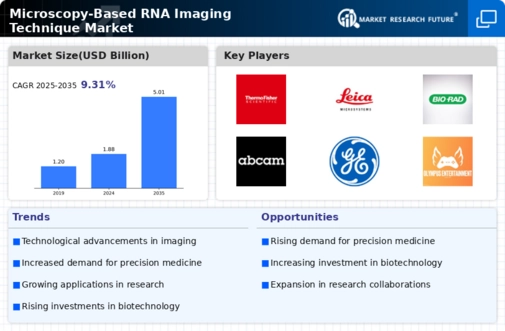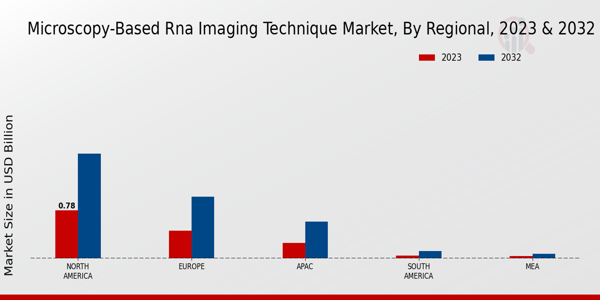Market Growth Projections
The Global Microscopy-Based RNA Imaging Technique Market Industry is poised for substantial growth, with projections indicating a market size of 1.88 USD Billion in 2024 and an anticipated increase to 5.01 USD Billion by 2035. This growth trajectory reflects a compound annual growth rate (CAGR) of 9.31% from 2025 to 2035. The increasing demand for innovative imaging solutions, coupled with advancements in technology and rising investments in life sciences research, underscores the market's potential. As the industry evolves, stakeholders are likely to explore new applications and collaborations, further driving market dynamics.
Focus on Personalized Medicine
The shift towards personalized medicine is a key driver of the Global Microscopy-Based RNA Imaging Technique Market Industry. As healthcare evolves, there is a growing emphasis on tailoring treatments based on individual genetic profiles. Microscopy-based RNA imaging techniques provide critical insights into gene expression patterns, enabling clinicians to make informed decisions regarding treatment options. This approach not only enhances therapeutic efficacy but also minimizes adverse effects. The increasing adoption of personalized medicine is expected to propel market growth, as healthcare providers seek innovative solutions to improve patient care and outcomes.
Emerging Applications in Drug Development
Emerging applications of microscopy-based RNA imaging techniques in drug development are significantly influencing the Global Microscopy-Based RNA Imaging Technique Market Industry. Pharmaceutical companies are increasingly utilizing these techniques to assess drug efficacy and understand the molecular mechanisms of action. By visualizing RNA interactions within cells, researchers can identify potential drug targets and optimize therapeutic strategies. This trend is particularly relevant in the development of RNA-targeted therapies, which are gaining traction in the treatment of various diseases. The growing focus on drug development is likely to drive market expansion, as companies seek to leverage advanced imaging technologies for competitive advantage.
Rising Demand for Advanced Diagnostic Tools
The Global Microscopy-Based RNA Imaging Technique Market Industry is experiencing a surge in demand for advanced diagnostic tools. This trend is largely driven by the increasing prevalence of genetic disorders and cancers, which necessitate precise and early detection methods. For instance, the ability to visualize RNA molecules within cells enhances understanding of disease mechanisms, thereby improving diagnostic accuracy. As healthcare systems globally prioritize personalized medicine, the market is projected to reach 1.88 USD Billion in 2024, reflecting a growing investment in innovative imaging technologies that facilitate better patient outcomes.
Growing Investment in Life Sciences Research
The Global Microscopy-Based RNA Imaging Technique Market Industry benefits from increased investment in life sciences research. Governments and private sectors are allocating substantial funds to support research initiatives aimed at understanding complex biological systems. For example, funding for RNA research has seen a notable rise, facilitating the development of advanced imaging techniques. This influx of capital not only accelerates innovation but also fosters collaborations between academic institutions and industry players. As a result, the market is projected to expand significantly, reaching an estimated 5.01 USD Billion by 2035, underscoring the importance of RNA imaging in scientific discovery.
Technological Advancements in Imaging Techniques
Technological innovations play a pivotal role in shaping the Global Microscopy-Based RNA Imaging Technique Market Industry. Recent advancements in super-resolution microscopy and fluorescence in situ hybridization (FISH) have significantly improved the resolution and sensitivity of RNA imaging. These technologies enable researchers to visualize RNA dynamics in real-time, providing insights into cellular processes. The integration of artificial intelligence in image analysis further enhances the capabilities of these techniques. As a result, the market is expected to grow at a CAGR of 9.31% from 2025 to 2035, indicating a robust future driven by continuous technological evolution.













